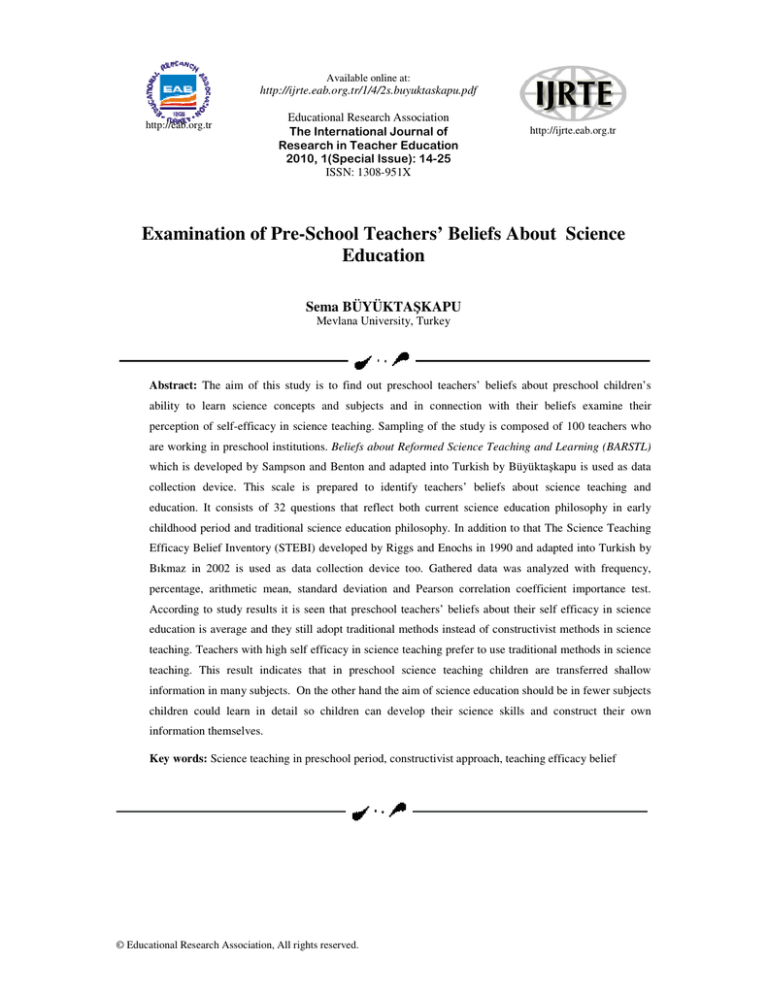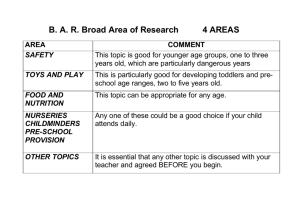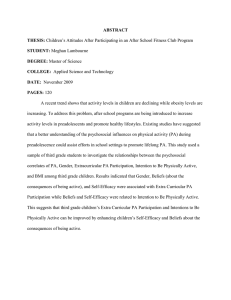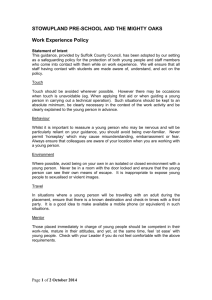
Available online at:
http://ijrte.eab.org.tr/1/4/2s.buyuktaskapu.pdf
http://eab.org.tr
Educational Research Association
The International Journal of
Research in Teacher Education
2010, 1(Special Issue): 14-25
ISSN: 1308-951X
http://ijrte.eab.org.tr
Examination of Pre-School Teachers’ Beliefs About Science
Education
Sema BÜYÜKTAŞKAPU
Mevlana University, Turkey
Abstract: The aim of this study is to find out preschool teachers’ beliefs about preschool children’s
ability to learn science concepts and subjects and in connection with their beliefs examine their
perception of self-efficacy in science teaching. Sampling of the study is composed of 100 teachers who
are working in preschool institutions. Beliefs about Reformed Science Teaching and Learning (BARSTL)
which is developed by Sampson and Benton and adapted into Turkish by Büyüktaşkapu is used as data
collection device. This scale is prepared to identify teachers’ beliefs about science teaching and
education. It consists of 32 questions that reflect both current science education philosophy in early
childhood period and traditional science education philosophy. In addition to that The Science Teaching
Efficacy Belief Inventory (STEBI) developed by Riggs and Enochs in 1990 and adapted into Turkish by
Bıkmaz in 2002 is used as data collection device too. Gathered data was analyzed with frequency,
percentage, arithmetic mean, standard deviation and Pearson correlation coefficient importance test.
According to study results it is seen that preschool teachers’ beliefs about their self efficacy in science
education is average and they still adopt traditional methods instead of constructivist methods in science
teaching. Teachers with high self efficacy in science teaching prefer to use traditional methods in science
teaching. This result indicates that in preschool science teaching children are transferred shallow
information in many subjects. On the other hand the aim of science education should be in fewer subjects
children could learn in detail so children can develop their science skills and construct their own
information themselves.
Key words: Science teaching in preschool period, constructivist approach, teaching efficacy belief
© Educational Research Association, All rights reserved.
Büyüktaşkapu, S. / IJERs 2011, 4(2):16-25
Introduction
Rote-learning in current education system is not creative and questioning, and also leads to
bringing up passive individuals who take everything as it is. However, for children to be self-sufficient
and successful individuals in their future lives and they need to have high level thinking and research
skills. Children who acquire research skills can reach to a lot of information for their daily lives via
scientific thinking and scientific processes.
Therefore, research activities that can develop scientific processing skills of children are to be
given place in the educational programs. These activities mostly take place in science programs.
Science programs can be prepared by educationalist by adopting two different approaches.
In the first approach, science education is accepted as the memorization of some facts children
are required to know, in the second approach it is regarded the studying the environment by making
use of processing skills (Wallace & Louden, 2002). The educationalist adopting the first approach
regard science students who remembers the information transmitted to them and answer questions
directed to them as successful science student (Solomon & Aikenhead, 1994). As they believe that
children are to learn scientific concepts like the concepts of number, color and shape (Bereiter, 1994)
they advocate that education programs should take traditional approach to the center.
In traditional science education even in times when “processing” , ”discovering” or “ putting
forward an idea” methods can be applied some certain scientific information and content are
emphasized, the content which is basically organized by adults is not taught (Kamii ve DeVries,
1993). Subjects, operations and activities which are taught to be the necessary part of children’s
education are focused on (Howe, 1993). It is based on experimental assumption which argues that
children learn things examining by means of five senses (smelling, listening, touching and tasting) and
through language (as a means of explaining things) (Kamii ve DeVries, 1993) After the topic is
chosen, simple experiments are carried out with explanations to make them understandable. The
teacher emphasis the results of the experiment and explains them in detail (Paulu & Martin, 1992;
Hildebrand, 1981; Harlan, 1976). This process only creates opportunities for scientific management
and the introduction of new words. However, these long explanations can cause children to lose
interest in the activity itself. According to Piaget, because of child’s difficulty in understanding the
language it is not beneficial to make long explanations before an idea about a topic is formed.
The educationalists who adopt the second view believe that science education is more than
memorizing or learning scientific concepts. According to the educationalists who adopt this view,
science education is a process and is a way discovering physical world (Merton & Storer, 1979). These
educationalists define a successful science student as individual who can think like a scientist
(Staver, 1998) and adopt constructivist approach in the preparation of teaching programs.
© Educational Research Association, All rights reserved.
16
Examination of Pre-School Teachers’ Beliefs About Science Education
Contary to traditional approach, in constructivst approach other than loading students with
ready made information teachers try to make them acquire knowledge and skills required to reach to
information. Knowledge acquisition is not a result but is a source used for the formation of new
information (Brook & Brooks, 1993; Marlowe & Page, 1998).
In constructivist science education learners are enabled to grasp events in interaction with
physical world, interpreting them with their own concepts (Scott, Asoko, Driver & Emberton içinde
Fensham, Gunstone & White, 1994). Individual constructs knowledge instead of learning it from an
authority or the teacher (Sherman, 2000; Tobin & Tippins, 1993). Individual relates new informationwhich s/he acquires as a result of interaction with the events and objects in the environment-with
his/her existent knowledge (Bodner, 1986; Fosnot, 1996; Limon,2001; Sherman,2000).
The results of the studies aiming to reveal which one of these two approaches are more effective
in science education indicate that science education programs are to be prepared based on
constructivist approach to train inquisitive, researching, questioning, criticizing and producing
individuals (French, 2004; Gelman &Brennenman, 2004; Aydın ve Balım, 2005; Tsai, 2007; Yanpar
ve diğerleri, 2006; DeBoer, 2002; Lavonen & Laaksonen, 2009; Orhan, 2004; Roberts, 2007; Chall,
2000; Balcı, 2007).
Furthermore, it is observed that the teacher who adopt traditional approach, who teach
teacher-centered courses and who leads classes by reading course books have low self-efficacies
(Henson, 2001; Plourde, 2001).
According to the results of this study, it is important that pre-school teachers are to adopt
constructivist approach when preparing science education programs and have higher science education
self-efficiency perception levels to bring up a new generation of scientists.
The determination of the approach and self-efficacy of the teachers in science education, This
study -hoping to shed light on teacher training applications- aims to determine whether teachers in preschool science education adopt a role of guide in children’s construction of information and to
determine their science self-efficacy perceptions. In line with this general aim, answers to the
following questions were sought:
a. What is the self-efficacy level of pre-school teachers about science education?
b. What is the approach the teachers participating the study adopt in pre-school science
education?
c. Is there a relation between the approach participant teachers use in pre-school science
education and their self-efficacy perceptions of science education?
The International Journal of Educational Research (IJERs)
17
Büyüktaşkapu, S. / IJERs 2011, 4(2):16-25
Method
Sample
This study was carried on 100 teachers who are working in pre-school education institutions in
2009-2010 education year.
Measurement
As means of data collection Science Education and Teaching Belief Scale (BARSTL )
developed by Sampson and Benton and adopted to Turkish by Büyüktaşkapu and Science Teaching
Self-efficacy Belief Scale developed by Riggs and Enochs in 1990 and adopted to Turkish by Bıkmaz
(2002) were used.
“Class Teachers’ Science Teaching Self-efficacy Belief Scale” developed by Riggs and
Enochs in 1990 is composed of 25 items and two factors, namely; Personal Science Teaching Efficacy
Belief and Science Teaching Outcome Expectancy. In the scale designed in Likert type, the answers
are designed in five choices (I Certainly Agree, I Agree, I am Indecisive, I disagree, I Certainly
Disagree). According to validity results, the scale had two factors as in the original scale, but the
number of items decreased to 20. In the scale redesigned as a result of adaptation to Turkish Science
Teaching Self-efficacy belief factor is composed of 13 items. Of these items 5 are positive 8 are
negative. The lowest score to be received from this factor is 13, the highest score is 65, and the Alfa
value is .78. The factor named Science Teaching Outcome Expectancy is composed of 7 items, 5 of
which are positive and 2 of which are negative. The lowest score to get from this factor is 7 and the
highest score is 35. The Alpha value of this factor is .78. The reliability coefficient of the whole scale
is .71, the highest score to be received is 100 and the lowest score is 20 (Bıkmaz, 2004).
Science Education and Teaching Belief Scale (BARSTL) developed by Sampson and Benton
in 2006 is composed of 32 items to determine teachers beliefs about science education and teaching.
BARSTL Scale has 16 items which reflect Constructivist Approach as science education strategy in
early childhood period and 16 items which reflect traditional science education strategy. In science
education, constructivist approach sub-scale includes conceptual development (4 items), planning and
applying lesson (4 items), teacher and education environment (4 items) and science curriculum (4
items). The items in science education traditional approach sub-scale are conceptual development (4
items), lesson planning and application (4 items), teacher and education environment (4 item) and
science curriculum (4 items). Science education constructivist approach sub-scale has four factors as
in the original scale, however 3 items were omitted. Traditional Approach sub-scale had four items as
in original scale, however 2 items were omitted. A total of 5 items were omitted from the two subscales and the number of items decreased to 27. Science education in constructivist approach sub-scale
© Educational Research Association, All rights reserved.
18
Examination of Pre-School Teachers’ Beliefs About Science Education
explains 59% of total variance, traditional approach in science education sub-scale explains 61% of
total variance. The Cronbach Alpha reliability coefficient is .71.
Results
In this part of the study findings and interpretations based on the data obtained in the study are
given.
a. What is the science teaching self-efficacy belief level of pre-school teachers?
The direction and mean values of the questions of the scale administrated to measure science
teaching self-efficacy levels of the teachers working in pre-school education institutions are given in
Table 1.
Table 1. Directions and means of the questions in science self-efficacy scale
1. If always find better teaching ways in Science teaching
Direction
+
Mean
3,70
2. Although I try hard, I cannot teach science lesson as well as I teach other lessons
3. I know the necessary steps to teach science concepts.
4. I am not very efficient in designed and controlling science experiments.
+
_
3,64
3,60
3,56
5. If a student is less successful than S/he can be, this is most probably because of
inefficient science teaching.
+
3,36
6. Generally I cannot teach science lesson well.
7. Generally the reason for some students’ being unsuccessful cannot be the teacher.
8. The reason why a child with low science success to show improvement is that
his/her teacher show greater interest in this child than normally.
9. I know science concepts well enough to teach basic science effectively.
10. Teacher making more effort in Science teaching does not make a significant
change in science success of some teachers.
11. Teachers are responsible for students’ success in science class.
12. Students’ success in science class is directly related with teachers efficiency in
science teaching
+
3,68
2,79
3,37
+
-
3,25
3,32
+
+
3,14
3,97
+
3,90
-
3,36
+
+
-
3,68
2.91
3.02
-
3,04
+
4,18
-
3,58
13. If it is commented that parents are more interested in science lesson of their
children, this probably stems from teachers performance.
14. I have difficulty in explaining students why experiments in science classes are
successful.
15. I can answer students’ questions about science at ideal standards.
16. I wonder whether I have necessary skills for science teaching.
17. I had a chance to make preference, I would not invite school director to assess
my science teaching.
18. If a student has difficulty in learning any science concept, I cannot know how to
help him/her understand it better.
19. When teaching science class I am pleased to answer questions of students about
science.
20.I do not know what I can do to direct students to the field of science
The International Journal of Educational Research (IJERs)
19
Büyüktaşkapu, S. / IJERs 2011, 4(2):16-25
When Table 1 is examined, it is seen that the mean self-efficacy scores of the teachers in
preschool education institutions is 3.45. According to these results, it can be said that teachers’ science
teaching self-efficacy scores are high.
b. What is the approach participant teachers adopt in pre-school science teaching?
The mean values of the questions of the scale carried out to determine pre-school science
education and teaching beliefs of teachers working in pre-school education institutions are given in
Table 2.
Table 2. Mean Score Teachers Get from BARST Constructivist Approach
Sub-scale and Traditional Approach Sub-scale
Constructivist
Approach
Đtem
Mean Score
1
3
6
9
11
12
16
17
21
22
26
30
31
2.79
2.32
1.73
2.67
1.70
1.70
2.06
2.39
2.90
1.90
2.23
2.59
2.43
Traditional Approach
Đtem
Mean Score
4
5
7
8
10
14
19
20
23
24
27
28
29
32
1.75
2.28
2.06
3.30
3.16
3.36
3.39
3.14
2.42
2.85
2.00
3.23
2.02
2.87
When Table 2 is examined, it is seen that the general average of the constructivist sub-scale of
Science Education and Teaching Belief Scale (BARSTL) applied to the teachers working in preschool education institutions is 2.28 and that of traditional approach sub-scale is 2.70. According to
these results, it can be concluded that teachers working in pre-school education institutions adopt
traditional approach more than constructivist approach in science activities.
c. Is there a relation between the approach participant teachers use in pre-school science
teaching and their self-efficacy perceptions about science teaching?
Pearson Correlation coefficient was calculated to examine the relation between the views of
the teachers working in pre-school education institutions about constructivist approach and their selfefficacy beliefs about science teaching and given in the table below.
© Educational Research Association, All rights reserved.
20
Examination of Pre-School Teachers’ Beliefs About Science Education
Table 3. The Correlation Coefficient Significance Test of the Scores Teachers got from BARSTL
Constructivist Approach Sub-scale and Science Teaching Self-efficacy Belief Scale
BARSTL Constructivist
Approach Sub-scale
Pearson Correlation
Sig (2-tailed)
N
Science Teaching Self-efficacy
Belief Scale
-.32
.02*
100
When the relation between pre-school teachers level of using teaching strategies based on
constructivist approach in science teaching and science teaching self-efficacy beliefs is examined,
there found a statistically significant (p<0.05) and negative relation between BARSTL Constructivist
Approach Sub Scale scores and Science Teaching Self-efficacy Belief Scale scores (r= -0.32). In line
with these findings, it can be said that while teachers’ belief in constructivist approach in pre-school
science activities increased, their self-efficacy perceptions in science teaching decreased.
Besides, to examine the relation between views of teachers -working in pre-school education
institutions- about traditional approach and their science teaching self-efficacy belief levels Pearson
Correlation coefficient was calculated and given in the table below.
Table 4. The Correlation Coefficient Significance Test of the Scores Teachers got from BARSTL
Traditional Approach Sub-scale and Science Teaching Self-efficacy Belief Scale
BARSTL Traditional
Approach Sub-scale
Pearson Correlation
Sig (2-tailed)
N
Science Teaching Self-efficacy
Belief Scale
.20
.04*
100
When the relation between pre-school teachers level of using teaching strategies based on
traditional approach and science teaching self-efficacy beliefs, it was determined that there is a
statistically significant (p<0.05) ad positive relation between BARSTL Traditional Approach Subscale scores and Science Teaching Self-efficacy Belief Scale (r=0.20). In line with these findings, it
can be said that teachers who adopt traditional approach in pre-school science activities have higher
self-efficacy perceptions about science teaching.
Conclusion and Suggestion
It was found out that pre-school teachers did not adopt constructivist approach which has been
applied for several years in science teaching, and still adopt teaching based on traditional approach.
The International Journal of Educational Research (IJERs)
21
Büyüktaşkapu, S. / IJERs 2011, 4(2):16-25
Besides, it was found out that pre-school teachers participating the study have high level of
self-efficacy belief in pre-school science teaching. Considering that self-efficacy belief can affect
teacher attitudes like making effort, giving feedback and being able to give field specific teaching
(Riggs&Enochs,1990), teachers having high pre-school science teaching self-efficacy belief will affect
the quality of the education they will give. However, research findings indicate that teachers with high
science teaching efficacy score adopt traditional approach in preschool science teaching. On the other
hand, while teachers’ belief in constructivist approach in pre-school science education increases, their
self-efficacy perceptions decrease.
As self-efficacy levels of teachers who adopt traditional approach in science teaching
planning and application are higher than those who adopt constructivist approach, it can be concluded
that teaching approach teachers adopt affects their affective characteristics.
Özden, Akdağ, Ekmekçi (2009) studied the relation between pre-school teachers pedagogical
subject knowledge about science education and self-efficacy belief levels and self-efficacy belief
levels. According to the result of the study, pre-school teachers (62%) prefer traditional teachercentered teaching methods like presentation and question-answer and their science teaching selfefficacy belief levels (51%) is not at required level.
Besides, in studies on self-efficacy it is seen that teacher candidates’ self-efficacy beliefs are
higher than medium level (Sarıkaya, 2004; Altunçekiç, Yaman and Koray, 2005). Therefore, the
results of this study are completely parallel with the results of the studies in the literature.
As teachers not being knowledgeable about new development in teaching, not attaching
importance to alternative thinking ways in science activities can cause children to develop negative
attitudes towards science in future years, suggestions are made to bring teachers to a better level in
terms of pre-school science teaching.
As pre-school science activities are composed of research, experiment activities, they can be
easily adapted into student-centered teaching. Therefore, especially constructivist education approach
can be applied effectively in pre-school science activities. However, teachers who are to do educationteaching applications according to constructivist approach are to know constructivist approach very
well and to have all theoretical and practical information necessary. Therefore, insufficiencies or
deficiencies our teachers have are to be removed by given them in-service training by concerned
institutions.
Furthermore, books in which sample science syllabi and activities based on constructivist
approach are given are to be written to provide guidance for pre-school teachers.
© Educational Research Association, All rights reserved.
22
Examination of Pre-School Teachers’ Beliefs About Science Education
References:
Altunçekiç, A., Yaman, S. ; Koray, Ö. (2005), Öğretmen adaylarının öz-yeterlik inanç düzeyleri ve
problem çözme becerileri üzerine bir araştırma- Kastamonu ili örneği, Kastamonu Eğitim
Dergisi, 13(1), 93-102.
Aydın, G.; Balım, A., (2005) Yapılandırmacı Yaklaşıma Göre Modellendirilmiş Disiplinler Arası
Uygulama: Enerji Konularının Öğretimi. Ankara Üniversitesi Eğitim Bilimleri fakültesi Dergisi,
Cilt.38, Sayı.2, 145 -166.
Balcı, A. S. (2007). Fen Öğretiminde Yapılandırmacı Yaklaşım Uygulamasının Etkisi. Selçuk Üniv.
Fen Bilimleri Enstitüsü. Yayımlanmamış Yüksek Lisans Tezi.
Bereiter, C. (1994). Implications of postmodernism for science, or, science as progressive discourse.
Educational Psychologist, 29(1), 3-12.
Bıkmaz, F.(2004) Sınıf Öğretmenlerinin Fen Öğretiminde Öz Yeterlilik Đnancı" Ölçeğinin Geçerlik Ve
Güvenirlik Çalışması. Milli Eğitim Dergisi. Sayı 161.
Bodner. G. M. (1986). Constructivism: A Theory of Knowledge. Journal of Chemical Education, 63
(10), 873-878.
Brooks, J. G., & Brooks, M. G. (1993). In search for understanding the case for constructivist
classrooms. Alexandria, Virginia: ASCD.
Chall, J.S. (2000). The academic achievement challenge: What really works in the classroom? New
York: Guilford Press.
DeBoer, G. E. (2002a). Student-centered teaching in a standards-based world: Finding a sensible
balance. Science and Education, 11(4), 405-417.
Fosnot. E. T. (1996). Constructivism: Theory, Perspectives, and Practice. New York and London:
Teachers College Press.
French, L. (2004). Science as the center of a coherent, integrated, early childhood curriculum. Early
Childhood Research Quarterly, 19(1), 138-149.
Gelman, R., and Brenneman, K. (2004). Science learning pathways for young children. Early
ChildhoodResearch Quarterly, 19(1), 150-158.
Harlan, J. (1976) Science Experiences for the Early Childhood Years (Columbus, Ohio, Charles E.
Merrill Publishing Co).
Henson R. K.(2001). Teacher self-efficacy: substantive ımplications and measurement dilemmas.
Paper presented at the annual meeting of the educational research exchange Hildebrand, V.
(1981) Introduction to Early Childhood Education (New York, Macmillan Publishing Co).
The International Journal of Educational Research (IJERs)
23
Büyüktaşkapu, S. / IJERs 2011, 4(2):16-25
Hildebrand, V. (1981) Introduction to Early Childhood Education (New York, Macmillan Publishing
Co).
Howe,A. (1993). Science in early childhood education. In B. Spodek (Ed), Handbook of research on
the education of young children (pp.225-235). New York: Macmillan Publishing Company
Kamii, C., & DeVries, R. (1978/1993). Physical knowledge in preschool education: Implications of
Piaget's theory. New York: Teachers College Press.
Lavonen, J.; Laaksonen, S. (2009). Context of Teaching and Learning School Science in Finland:
Reflections on PISA 2006 Results. Journal of Research in Science Teaching, 46, 922-944.
Limon, M. (2001). On the Cognitive Conflict as an Instructional Strategy for Conceptual Changes: a
Critical Appraisal.Learning and Instruction, 36(4-5), 357-380.
Marlowe, A. B., & Page, L. M. (1998) Creating and sustaining the constructivist classroom.
California: Corwin Press.
Merton, R. K., & Storer, N. W. (1979). The Sociology of Science. Chicago: University of Chicago
Press.
Orhan, A. T. (2004). Fen Bilgisi Öğretmen Adaylarına Fotosentez Konusunun Öğretiminde Yapısalcı
Yaklaşımın Etkileri Đle Geleneksel Öğretim Yönteminin Karşılaştırılması. Yayımlanmamış
Yüksek Lisans Tezi. Gazi Üniversitesi Eğitim Bilimleri Enstitüsü, Ankara.
Özden, M.; Akdağ G.; Ekmekçi, S. (2009). Okul Öncesi Öğretmenlerinin Fen Öğretimine Đlişkin
Pedagojik Alan Bilgileri Đle Öz Yeterlilik Đnanç Düzeyleri Arasındaki Đlişkinin Araştırılması,
XVIII. Ulusal Eğitim Bilimleri Kurultayı, Đzmir.
Paulu, N. & Martin, M. (1992) Helping Your Child Learn Science (Washington, US Department of
Education).
Plourde, L.A.(2001). The genesis of science teaching ın the elementary school: the ınfluence of
student teaching http://www.ed.psu.edu/CI/Journals/2001aets/su1_08_plourde.rtf. 07.08.2006
Riggs, I. M., and Enochs L. G. (1990). Toward The Development of an Elementary Teacher’s Science
Teaching Efficacy Belief Instrument. Science Education, 74 (69), 625-637.
Roberts, D.A. (2007). Scientific literacy/science literacy. In: S.K. Abell & N.G. Lederman (Eds.),
Handbook of research on science education (pp. 729–780.). New York: Routledge.
Sampson, V., Benton, A. (2006). Development and validation of the Beliefs about Science Teaching
and Learning (BARSTL) Questionnaire. Paper presented at the annual meeting of the
Association for Science Teacher Education, Portland, OR.
© Educational Research Association, All rights reserved.
24
Examination of Pre-School Teachers’ Beliefs About Science Education
Sarıkaya, H. (2004), Sınıf öğretmeni adaylarının bilgi düzeyleri fen öğretimine yönelik tutum ve özyeterlik inançları,Yüksek Lisans Tezi, Ortadoğu Üniversitesi. Orta Öğretim Fen ve Matematik
Alanları Eğitimi Bölümü, Ankara.
Scott, P., Asoko, H., Driver, R., Emberton, J. (1994) Working from Children’s Ideas: Planning and
Teaching a Chemistry Topic from a Constructivist Perspective içinde Fensham, P., Gunstone, P.,
White, R. The Content of Science. The Falmer Press.
Sherman. J. S. (2000). Science and Science Teaching. U.S.A.: The College of New Jersey.
Solomon, J., & Aikenhead, G. S. (1994). STS Education: International Perspectives on Reform. Ways
of Knowing Science Series. New York, NY: Teachers College Press, 1234 Amsterdam Ave.,
New York.
Staver, J. R. (1998). Constructivism: Sound theory for explicating the practice of science and science
teaching. Journal of Research in Science Teaching, 35(5), 501-520.
Tobin, K., Tippins, D. (1993). Constructivism as a Referent for Teaching and Learning. In K. Tobin
(ed.), The Practice of Constructivism in Science Education (pp.3-38).Hillsdale,NJ: Lawrence
Erlbaum Associates
Tsai, C. (2007). Teachers’ scientific epistemological views: The coherence with instruction and
students’ views. Science Education, 91, 222–243.
Yanpar, T. , Hazer, B. , Arslan, A. (2006). 10. Sınıf Çözünürlük Konusunda Oluşturmacı öğrenme
Yaklaşımına dayalı Grup Çalışmalarının Kullanılması. Đnönü Üniversitesi Eğitim Fakültesi
Dergisi, Cilt. 7, Sayı: 11, S: 113-122.
Wallace, J., Louden, W. (2002). Dilemmas of Science. New York, NY: Routledge Falmer 2 Park
Square, Milton Park, Abingdon, Oxon, OX14 4RN.
About the Author(s):
Sema BÜYÜKTAŞKAPU, Ph.D., Child Development Department, Selçuk University, Konya/Turkey. research
fields: educational research, science teaching in preschool period, teacher’s educational research
The International Journal of Educational Research (IJERs)
25




